View in other NatureServe Network Field Guides
NatureServe
Montana
Utah
Wyoming
Idaho
Wisconsin
British Columbia
South Carolina
Yukon
California
New York
Magnum Mantleslug - Magnipelta mycophaga
Other Names:
Montana-Idaho Slug, Spotted Slug
General Description
A large slug unlikely to be confused regionally, up to 80 mm extended. Dorsal base color tan with scattered brown to black markings of varying density throughout and an irregular brown to black stripe on either side of the mantle, the mantle smooth and covering 2/3 or more of the body. Anterior quarter of the mantle is free from the head. The pneumostome is slightly posterior to the midline of the mantle on the right side. The tail is unkeeled and the sole undivided (not tripartite); the mucous is clear. Disturbed individuals may flare the anterior portion and sides of the mantle out and upward (Hendricks 2012, Burke 2013). Internal anatomy is described by Pilsbry and Brunson (1954) and Webb and Russell (1977).
Diagnostic Characteristics
A combination of size, body morphology and markings differentiate this species from other slugs in Montana. The length of the mantle (> 2/3 of the body length) is unique.
Species Range
Montana Range
Range Descriptions
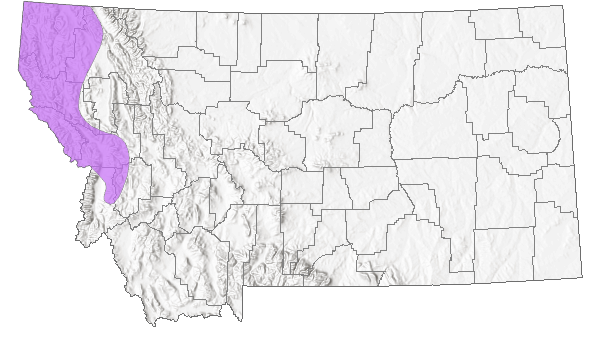
 Native
Native
Range Comments
Southeastern British Columbia, northeastern Washington, northern Idaho and adjacent northwestern Montana west of the Continental Divide (Burke 2013). In Montana, 35 records in seven counties: Flathead (3), Granite (3), Lincoln (7), Mineral (4), Missoula (11), Ravalli (2), Sanders (5). Elevation range is 840 to 2211 m (2756 to 7254 ft). Originally described from a specimen near Lolo Pass in Clearwater County, Idaho. Can be locally abundant; 32 individuals were found at one Missoula County, Montana site in late May and 86 at another in early June (Hendricks 2012).
Observations in Montana Natural Heritage Program Database
Number of Observations: 46
(Click on the following maps and charts to see full sized version)
Map Help and Descriptions
Relative Density
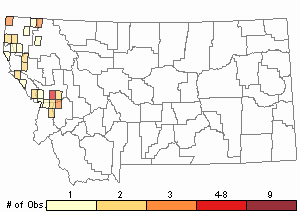
Recency

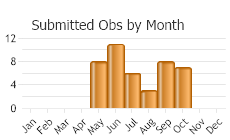
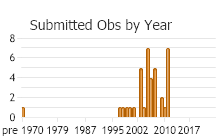
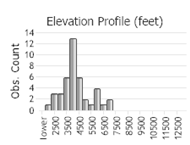 (Observations spanning multiple months or years are excluded from time charts)
(Observations spanning multiple months or years are excluded from time charts)
Migration
No information.
Habitat
Mostly mesic mixed conifer forest and riparian woodlands, sometimes with talus, also at higher elevation in drier sites with sufficient ground cover to maintain elevated soil moisture. Canopy species include Engelmann spruce, subalpine fir, lodgepole pine, Douglas-fir, western hemlock, western redcedar, grand fir, western larch, ponderosa pine, black cottonwood, with secondary canopy species including alder, willow, dogwood, and mountain maple. Usually found under rocks and woody debris, sometimes in rotten logs (Hendricks 2012).
Food Habits
Magnipelta mycophaga feeds on green plant material, possibly including moss (Brunson and Kevern 1963).
Reproductive Characteristics
Copulation in the wild has been observed in late May.
Stewardship Responsibility
Threats or Limiting Factors
Habitat occupied by Magnipelta mycophaga (moderate elevation mixed conifer forest, especially spruce-fir, often near water) is threatened by logging, grazing, fire, possibly rural home development, and possibly recreation and weed control. The impact of fire retardant on this and other terrestrial mollusks is not known. Little is known about this species, including sensitivity to disturbance.
References
- Literature Cited AboveLegend:
 View Online Publication
View Online Publication Burke, T. E. 2013. Land snails and slugs of the Pacific Northwest. Corvallis, OR: Oregon State University Press. 344 p.
Burke, T. E. 2013. Land snails and slugs of the Pacific Northwest. Corvallis, OR: Oregon State University Press. 344 p. Hendricks, P. 2012. A Guide to the Land Snails and Slugs of Montana. A report to the U.S. Forest Service - Region 1. Montana Natural Heritage Program, Helena, MT. vii + 187 pp. plus appendices.
Hendricks, P. 2012. A Guide to the Land Snails and Slugs of Montana. A report to the U.S. Forest Service - Region 1. Montana Natural Heritage Program, Helena, MT. vii + 187 pp. plus appendices. Pilsbry, H.A. and R.B. Brunson. 1954. The Idaho-Montana slug Magnipelta (Arionidae). Notulae Naturae, The Academy of Natural Sciences of Philadelphia 262:1-6.
Pilsbry, H.A. and R.B. Brunson. 1954. The Idaho-Montana slug Magnipelta (Arionidae). Notulae Naturae, The Academy of Natural Sciences of Philadelphia 262:1-6. Webb, G.R. and R.H. Russell. 1977. Anatomical notes on a Magnipelta: Camaenidae? Gastropodia 1:107-108.
Webb, G.R. and R.H. Russell. 1977. Anatomical notes on a Magnipelta: Camaenidae? Gastropodia 1:107-108.
- Additional ReferencesLegend:
 View Online Publication
View Online Publication
Do you know of a citation we're missing? Brunson, R.B. and N. Kevern. 1963. Observations of a colony of Magnipelta. Nautilus July:23-27.
Brunson, R.B. and N. Kevern. 1963. Observations of a colony of Magnipelta. Nautilus July:23-27. Forrester, Donald J. 1962. Land Molluska as Possible Intermediate Hosts of Protostrongylus stilesi, a Lungworm of Bighorn Sheep in Western Montana. Proceedings of the Montana Academy of Sciences, 22: 82-92.
Forrester, Donald J. 1962. Land Molluska as Possible Intermediate Hosts of Protostrongylus stilesi, a Lungworm of Bighorn Sheep in Western Montana. Proceedings of the Montana Academy of Sciences, 22: 82-92. Forsyth, R.G. 2004. Land snails of British Columbia. Royal British Columbia Museum: Victoria, British Columbia, Canada. 188 pp.
Forsyth, R.G. 2004. Land snails of British Columbia. Royal British Columbia Museum: Victoria, British Columbia, Canada. 188 pp. Frest, T.J. and E.J. Johannes. 1995. Interior Columbia Basin mollusk species of special concern. Final report to the Interior Columbia Basin Ecosystem Management Project, Walla Walla, WA. Contract #43-0E00-4-9112. 274 pp. plus appendices.
Frest, T.J. and E.J. Johannes. 1995. Interior Columbia Basin mollusk species of special concern. Final report to the Interior Columbia Basin Ecosystem Management Project, Walla Walla, WA. Contract #43-0E00-4-9112. 274 pp. plus appendices. Frest, T.J. and E.J. Johannes. 2001. An annotated checklist of Idaho land and freshwater mollusks. Journal of the Idaho Academy of Science 36(2):1-51.
Frest, T.J. and E.J. Johannes. 2001. An annotated checklist of Idaho land and freshwater mollusks. Journal of the Idaho Academy of Science 36(2):1-51. Grimm, F.W., R.G. Forsyth, F.W. Schueler, and A. Karstad. 2009. Identifying land snails and slugs in Canada: introduced species and native genera. Canadian Food Inspection Agency, Ottawa, ON. 168 pp.
Grimm, F.W., R.G. Forsyth, F.W. Schueler, and A. Karstad. 2009. Identifying land snails and slugs in Canada: introduced species and native genera. Canadian Food Inspection Agency, Ottawa, ON. 168 pp. Hendricks, P. 2003. Status and conservation management of terrestrial mollusks of special concern in Montana. Unpublished report prepared for the U.S. Forest Service. Montana Natural Heritage Program, Helena, Montana. 67 pp. + appendices.
Hendricks, P. 2003. Status and conservation management of terrestrial mollusks of special concern in Montana. Unpublished report prepared for the U.S. Forest Service. Montana Natural Heritage Program, Helena, Montana. 67 pp. + appendices. Hendricks, P. 2005. Surveys for animal species of concern in northwestern Montana. Unpublished report to the Montana Department of Fish, Wildlife & Parks, Montana Natural Heritage Program, Helena, Montana, May 2005. 53 p.
Hendricks, P. 2005. Surveys for animal species of concern in northwestern Montana. Unpublished report to the Montana Department of Fish, Wildlife & Parks, Montana Natural Heritage Program, Helena, Montana, May 2005. 53 p. Hendricks, P., B.A. Maxell, S. Lenard, and C. Currier. 2007. Land mollusk surveys on USFS Northern Region lands: 2006. A report to the USDA Forest Service, Northern Region. Montana Natural Heritage Program, Helena, Montana. 11 pp. plus appendices.
Hendricks, P., B.A. Maxell, S. Lenard, and C. Currier. 2007. Land mollusk surveys on USFS Northern Region lands: 2006. A report to the USDA Forest Service, Northern Region. Montana Natural Heritage Program, Helena, Montana. 11 pp. plus appendices. Hendricks, P., B.A. Maxell, S. Lenard, and C. Currier. 2008. Surveys and predicted distribution models for land mollusks on USFS Northern Region Lands: 2007. Report to the USDA Forest Service, Northern Region. Helena, MT: Montana Natural Heritage Program. 12 pp. + appendices.
Hendricks, P., B.A. Maxell, S. Lenard, and C. Currier. 2008. Surveys and predicted distribution models for land mollusks on USFS Northern Region Lands: 2007. Report to the USDA Forest Service, Northern Region. Helena, MT: Montana Natural Heritage Program. 12 pp. + appendices. Pilsbry, H.A. 1953. Magnipelta, a new genus of Arionidae from Idaho. The Nautilus 67:37-38.
Pilsbry, H.A. 1953. Magnipelta, a new genus of Arionidae from Idaho. The Nautilus 67:37-38.
- Web Search Engines for Articles on "Magnum Mantleslug"
- Additional Sources of Information Related to "Snails / Slugs"





